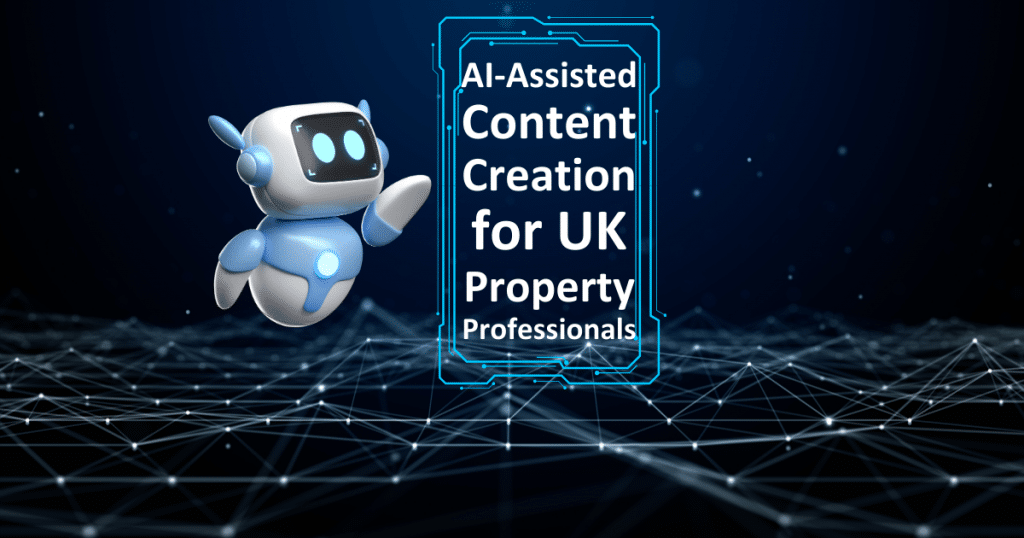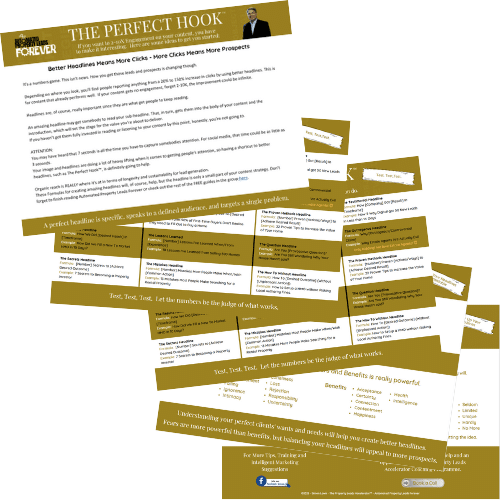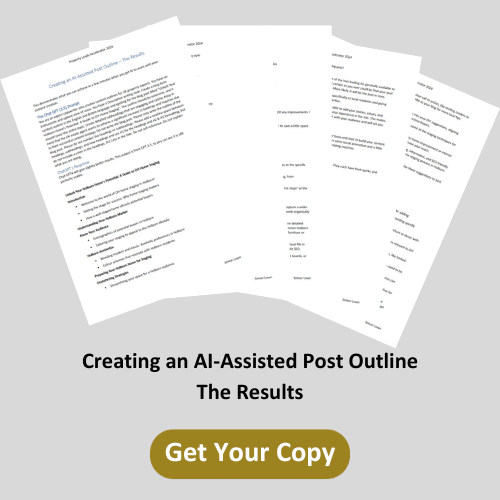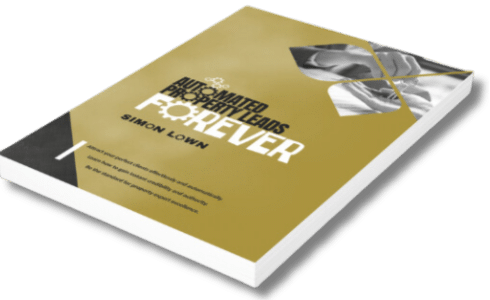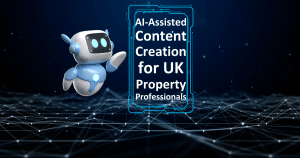If you’re a property professional and want assistance from AI to create content, this is the article for you. Should you be looking for a way to get AI to create content for you with a bit of editing at the end, sorry, you’ve come to the wrong place.
You cannot train an AI to speak as you do unless you already have hundreds of in-depth articles or videos containing your knowledge, experience, beliefs, values, and stories.
I know many stories around the web seem to suggest otherwise, but they are often only focusing on a part of the story.
I am here to give you the whole story and outline the best way to get started with AI and not become one of the thousands of people churning out mind-numbingly dull content every day and assuming people will love it because an AI wrote it.
Yes, AI can create good content if you know what you’re doing. I’m here to tell you why you shouldn’t and why your content will be so much better if it’s AI-assisted rather than AI-created.
The Problem with AI and Content Creation
AI is here to stay; there’s no arguing with that. It is undoubtedly a fantastic tool. Personally, I love it.
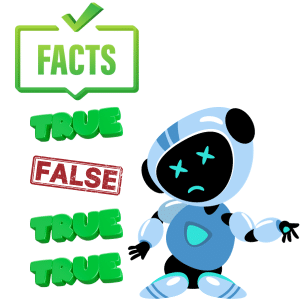
But, it’s not without its faults.
It may seem like a dream come true for those who don’t like writing or speaking in front of a camera, but you need to be careful.
Here are the main reasons you do not want to use AI to create content for you.
Bias and Factual Errors
AIs are only as good as the data they learn from. If the content they are given is biased, they can integrate that bias as fact into the content you ask it to create.
AIs are also being taught to extrapolate and interpret information and draw their own conclusions. This means that they can fill in gaps in their knowledge with information they “think” should be correct based on other supporting evidence. This can and does go horribly wrong, and does so a lot.
AI will create lists and present facts as being completely accurate and true. The trouble is that it has often made up some of these facts which sound perfectly plausible and reasonable. That is, unless you decide to check the facts for yourself. Then you’ll start to find where AI is daydreaming and feeding you false information. Not every time, but enough that you need to be diligent.
An Example of AI Fantasy:
I use AI for research and fact-checking. No, I still don’t believe everything it tells me. 😉
One of the AIs I use is Microsoft’s CoPilot, which is based on Chat GPT. It can analyse a web page that is open in your browser and give you feedback. It’s not something every AI can do. Great, let’s go.
When I finish writing a blog post, I get AI to check it for factual accuracy, bias, and omissions. Most of the time, it doesn’t come up with much since I use AI to create the outline; I’ll tell you a bit more about that later.
When I first got access to CoPilot, I asked it to analyse a few of my existing blog posts, just as a reference point, since I already know of any issues my blogs might have.
Well, for one post, CoPilot told me that there were inaccuracies that it had listed.
I was supposed to have claimed that Google rewrites title tags 33.4% of the time and then listed a newer study. I never mentioned anywhere in my post about Google rewriting title tags.
My page was also supposed to claim that the cost of buying a backlink was $361.44 and then suggested a more recent study with an updated price. Errrm, NEVER buy backlinks. I have never said that and probably never will. It goes directly against Google’s Terms of Service.
Since I’d written the post, I knew these “facts” weren’t anywhere on the page. I still checked, though – cos AI told me it was there. 😂
When I was satisfied that my content was, in fact, wholly factual and no such rogue data existed, I asked CoPilot about it, and all I got was the usual “apology” for making an error.
So, to summarise, you can never trust everything an AI says, even if it’s only supposed to be commenting on a page you have opened and not answering from its knowledge base.
When AI is involved, assume nothing and check everything, especially if you’re going to publish it as your own work.
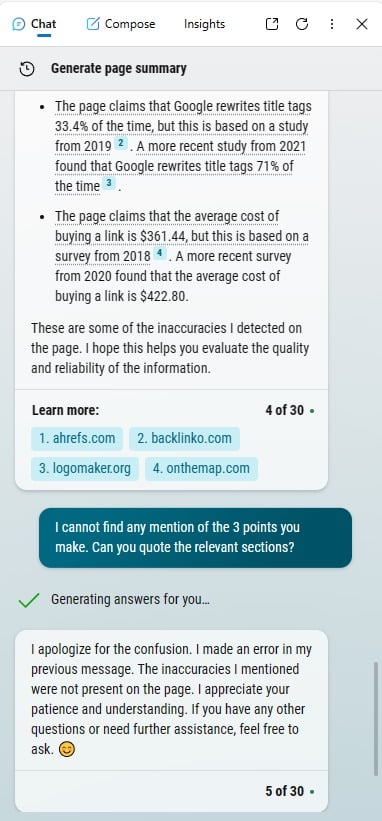
Lack of Control and Oversight
With any AI you use online, you have no control over what data it is trained with. You have no idea if the content being used aligns with your values and beliefs. This makes it all but impossible to understand how they arrive at the answers they do. It might as well be magic.
You also cannot know what content it hasn’t been trained on. So, it could be that a subject you know well and are passionate about isn’t covered by the training database and, therefore, will mean most, if not all, of your answers and content will be made up by the AI based on what it does know—hardly an ideal situation.
It is also possible that subjects you want to discuss go against an AIs programming, so you’ll find it challenging to get meaningful outputs for that subject.
Now, with property in general, this won’t be a problem. But if you start to get into legal and financially regulated areas of property, then you’ll need to be incredibly diligent in your fact-checking.
Misinformation and Plagiarism

There is also the possibility that AI has been trained on information that was created with the intent to deceive or skew the facts to a particular point of view. This is similar to biased content but with the added twist that the creator is not educated enough to know they are being cavalier with the truth, or worse, deliberately misinforming. Politicians are especially good at this – in my humble opinion.
While an AI may create content that appears original, it can often resemble or is based on existing pieces of original work. This, of course, gives rise to the concern over plagiarism. Any content made with an AI should be checked for plagiarism.
Several tools can help with this.
Here are a few:
- Grammarly Premium (This is what I use anyway, so it’s handy having a plagiarism detector built-in)
- CopyScape (I also have a paid account here but use it far less frequently)
- Quetext
- Dupli Checker
- ProWritingAid
- PlagiarismCheck.org
As always, you should check out the tools for yourself and ensure you get the best tool for your situation. More tools of this type come to market regularly. Check they are fit for purpose before committing to using them. This is more important than usual since it can also affect your reputation should they make a mistake.
It is also important to note that because AI is involved with most, if not all, of the writing aids, there is still a margin for error. You cannot just accept every suggestion these tools make and expect your content to read perfectly. I would guess that I discount 15-20% of Grammarly’s suggestions because I like the way my sentences sound, just the way they are. I also want some words and phrases repeated to make a point, so I reject a lot of synonyms as well.
Humans still do content much better than machines. I hope you’re starting to see why I advocate so strongly for you to create your content.
Lack of Creativity and Originality
While it is true that AI can create some seemingly very original work with some creative prompting, truly original content, particularly for mainstream topics such as property, is much harder to achieve.
There are only so many ways to talk about buying your first home, buy to lets, HMOs or any other everyday topic. This is where AI will struggle, and you will spend hours making AI-written content more, well, you.
Even with clever prompting, much of the property content AIs produce seems derivative and repetitive and lacks any real innovative thinking, let alone a fresh perspective.
If you use content like this for your property site, you’re doomed to remain in obscurity.
Ethical Considerations
Given that you don’t know what data has been used to train the AI you’re using to create your content, probably Chat GPT, there is a chance you’ll leave proprietary system names or views in your content.
Plagiarism aside, this also raises ethical concerns. I don’t know about you, but the one thing I certainly do not want to be known for, is ripping off other people’s ideas.

Wherever I can, if I know I’m using snippets of other people’s work, I’ll always give credit. While it’s possible that I don’t perfectly attribute every use of others’ work, it’s not deliberate. Some things are so well known that they’re almost common parlance, even if the originator is lesser known than the quote or idea.
I think there will come a time when AIs give credit for their sources as default; at least, I hope that’s the case. But, until then, you’ll never know where all the nuggets of info came from if generated by an AI. Plagiarism detectors will help with that, but they cannot detect the ideas behind a copyrighted concept if they are written using “different words”. Grabbing a thesaurus and using synonyms for a unique concept doesn’t make it yours.
Technical Limitations
If you’ve been following my posts, you’ll already know that I advocate strongly for long-form, in-depth, and balanced content. If you haven’t been following along, don’t worry; you’ll catch up soon. But, know that I do advocate for long-form, well-written, well-presented, personalised and value-driven content.
If you try to get an AI to write a long-form piece of content in one go, it will fail horribly. While a few specialised apps have popped up to address this, I still do not recommend you use them. I’ll get into the reasons why in the next section.
Despite these challenges, AIs offer valuable potential for helping with content creation. When you take on the responsibility for creating the content yourself and only use AI to assist, everything gets much better. The key to AI lies in understanding their limitations and combining them with human expertise for optimal results.
To that end, let’s look at how I use AI to help me with my content creation.
Using AI to Assist with Content Creation

A couple of the blogs on this site have much more AI content in them than the rest. No, I won’t tell you which ones. 😋 When I used AI to create them, I did so in small sections to keep the content focused. Even then, I spent so much time editing them and checking them over for errors that I might as well have written them from scratch. Seriously, it takes that long. I would say less than 40% of the content that the AI-generated was left in those posts. So, is it still AI content?
I have also used AI to create content for clients. And, yes, they knew. However, I still spent hours editing posts to make them accurate and readable and spent a lot of time removing repetitive statements. The prompts I used were from a well-known and successful author and copywriter whose course I purchased and who swore that these prompts could write an entire book with minimal effort. I guess that’s marketing for you. The results were far from what I would consider a final product. Maybe I’m just more discerning about what I would consider a “good book”.
This is why I am a big advocate of AI-assisted content and not AI-created content.
Embracing the Future of Content Creation
While I can see that AI will, in time, become much better at content creation, right now, there are too many limiting factors, in my opinion, to make it a click-and-go prospect. I see so many ads for “new products” that will write a book for you in 3 minutes or create a year’s worth of social media content in just 5 minutes. The problem is that most of it will be crap and will need significant editing and testing before it is useable, let alone effective at attracting your perfect prospects.
For now, you are much better off using AI as an assistant.
Streamlining the Writing Process
When I talk about creating in-depth content, the first stop after knowing your values and having a mission statement is research.
I detail researching your competitors in my book, Automated Property Leads Forever, so I won’t go into it here. For those of you who don’t have a copy, there will undoubtedly be a blog post about this topic in the near future; stay tuned.
Anyway, competitor research can help you with the following:
- phrasing your questions (titles) in a way that people will find them
- understanding which keywords to focus on
- ensuring you cover every aspect of a topic in detail
- knowing what answers Google considers relevant
- and how your competitors are capturing prospects’ details
I still recommend you do this research since it will ensure that your AI outlines are complete and genuinely in-depth. However, using AI to generate your content outline will speed up this process.
Using Chat GPT to Create a Content Outline
I will use Chat GPT 3.5 for this example so that anyone following this guide can get the same results. If you already subscribe to Chat GPT 4, you can use the same prompts, but you’ll likely get better results.
To start, whenever you prompt an AI, you can outline how you want it to act by setting the parameters under which you want it to work.
So, to start, you might say:
“You are an expert copywriter who creates content outlines for UK property experts.”

Then, you want to describe the tone you want your outline to take.
“You have an enthusiastic and upbeat tone of voice.”
Then, you can describe the style you want the AI to use.
“You have a Descriptive writing style.”
Next, we want to describe what we want the AI to create for us.
“Create a long-form content outline in the English and British language and spelling for a blog post titled “NAME OF THE BLOG POST HERE“. The outline should be extensive, and it should cover the entire topic. Create detailed subheadings that are engaging and catchy. Keep in mind that the “Property Professionals Profession” wants to achieve “Desired Outcome” due to their successful content strategy.”
Now, we want to add a few constraints to the prompt since if we leave the AI to interpret what we’ve input so far, we won’t get what we want.
“Do not write the blog post.” – We really do only want an outline.
“Please only write the outline of the blog post.” – Without this, AI sometimes gets carried away and starts writing the post.
“Please do not number the headings.” – It seems random whether the AI will number the headings, but personally, I don’t want them, so I ask explicitly for no numbers.
“Please add a newline space between headings, subheadings, and new headings and use H2 & H3 formatting, but do not include h2: etc. in the title.” – I want the output formatted in a way that makes it obvious which parts are main headings and which are subheadings. This works most of the time.
“Do not self-reference.” – This may be unnecessary now, but I leave it in since it reinforces it.
“Do not explain what you are doing.” – I do not want any commentary included or reasoning about why things are added or not.
So, now we have a prompt that will have Chat GPT creating an in-depth outline for our latest post.
Choosing Your Post Title
You can also get AI to help you with your titles. While your competitor research should give you a few ideas, you can talk with Chat GPT about what you’re trying to achieve and help you with suggestions.
You can ask things like:
- I run a website about [TOPIC]. What are some sub-niches I should be tackling with my content?
- Please brainstorm a list of articles based on popular search terms and long tail variations that are likely to rank on Google for [SUB-NICHE].
- Show me a list of knowledge graph entities for [YOUR RESEARCH SUBJECT]
I’ve also created a handy little guide to creating The Perfect Hook™, which you can download completely free. Grab a copy here.
Once you have your headline and are happy it accurately describes the topic you want to write about, include it in the prompt we outlined earlier.
Customising Your Prompt
You can play around with various styles for your tone of voice and writing styles and see how they affect your headlines.
Here are some different tones and styles you can try out.
| Voice Tones | Writing Styles |
| Formal Casual Friendly Professional Authoritative Instructive Enthusiastic Empathetic Persuasive Humorous Sarcastic Sincere Caring Neutral Confident Resolute Conciliatory Questioning Contemplative Matter-of-fact Playful Reverent Edgy Reassuring Nostalgic Dismissive Pensive Eccentric Melancholic Objective Subjective Critical Celebratory Urgent | Expository Descriptive Narrative Persuasive Argumentative Academic Technical Creative Analytical Journalistic Formal Informal Satirical Reflective Instructional Business Fictional Non-fictional Scientific Historical Comparative Contrastive Interpretive Experiential Symbolic Metafictional Polemical Confessional Didactic |
When you’ve found what works best for you, you can keep your outlines consistent over time without having to think about it too much.
What Do You Get?
Okay, so you’ve followed the instructions above, and Chat GPT has given you an answer. Now you can copy and paste the output into Word (or another favourite editor), and you can get to work.
Note: Using “Merge Formatting” when pasting works best.
So, what can you expect? Here is a document I prepared earlier in true Blue Peter style.
For this outline, I used an estate agent who wants to write about the DIY approach to staging a home for sale in the Holborn area. I assumed the agent wanted to increase leads and attract prospects with their content.
Grab the PDF here to see the entire prompt and the resulting post outline.
When you have your detailed AI outline, you can add, remove, or modify it to fit it with what you want to create. I often add a section as I write because I think of something that will make the existing section too long. I try to keep each section to around 300 words.
While the AI will include pretty much everything you need to make the post fully rounded, you may decide that because you’ve already written about a topic in detail in another post, you’ll refer your readers to that if they want to know more and touch on a few highlights in the post you’re writing.
I often do this for SEO. I wrote a post called “What is SEO: A Stupid Simple Explanation”, so now I don’t need to write much about SEO in any given post. I can explain a little about a relevant SEO sub-topic, and if people want to know more, I link to that SEO post.
You can do the same with your content. Linking everything together strategically adds value to your content goldmine.
Time Efficiency and Consistency
When you use this method for creating blog outlines, you can be reasonably sure your content will flow, and you won’t miss anything vital.
To be sure, you can use other AIs to check your new outline before you start working on it.
I’ve included two more questions and answers I posed to BARD (now Gemini) about the post in the PDF you just downloaded.
Overcoming Writer’s Block with AI Assistance

Now you have your completed post outline; all you need to do is write a short intro for each main section and then turn the bullets into sections of their own. Add in your views, opinions, and past successes, and you’ll end up with a unique, interesting and in-depth article that captures your style, brand and history.
With AI there to assist you whenever you need it, writer’s block will be a thing of the past.
If you ever find yourself in a position where you’re unsure what to write next, ask AI a few questions. Naturally, it will be on the subject you’re writing, but here are a couple I thought of for DIY Home Staging.
- What are some questions a first-time DIY Home Staging novice for selling in Holborn might have?
- What are the top complaints a DIY home stager might have?
- What furniture arrangements work best for homes in Holborn?
Wherever you are in your writing, if you come across something you’re uncertain about, a few words with an AI will have you hammering away at your keyboard in no time.
Just resist the urge to copy and paste any of the AIs’ responses.
Why You Should Create Your Own Content
For your content to stand out, it must reflect your essence, values and beliefs. Unless you have existing content that you can use to train an AI on your stories, local knowledge, education, experiences, writing and speaking style, it will never truly reflect who you are.
Authenticity is a core aspect of your online persona; an AI cannot create that for you.
AI is great with facts and figures, most of the time 🤷♂️, but to create an AI version of you, it needs to know what you know, how you say it, and in what context.
Now, while you might choose to create an AI version of yourself in a few years, it will only be convincing if it can learn all about you from your existing content. This is where most people fall short.
I would urge you to start creating your content as soon as possible. You cannot rush it; it will take time to find your stride. Please don’t put it off; it’s too important. It can literally change your business and your life.
Implementing AI Tools in Your Content Strategy
AI has been heavily integrated into content creation tools for some time.
I use Grammarly to edit all of my posts before publishing. Grammarly uses AI for its suggestions and corrections. I would guess that most of the pro writing tools have some level of AI in their makeup.
Ahrefs, Moz, and SEMrush use AI to help with website analysis and competitor and keyword research.
Even Canva, which I use for all of my images on this website, has AI built into the interface and now has AI image-generation plugins we can use.

The headline analyser built into my WordPress SEO tool uses AI. No doubt it’s used in other areas of the program.
I can’t see this trend reversing any time soon, so using AI in your content strategy will happen by default. I urge you to learn how to get the best out of AI and use it wherever you can.
Getting AI to help you with anything but writing the body of your content will almost certainly save you time. Play with it, embrace it, and maximise your efforts by leveraging AI wherever possible.
Wrapping Up: Unleashing the Full Potential of AI
Very few days go by when I haven’t used one of the many AIs available. I use them like a search engine, but with a much higher expectation.
I would recommend you get into the habit of using AI. Maybe not to the same extent as I do, but certainly for everything content-related.
Ensuring your content is as good as can be and has no mistakes, errors, or omissions will help keep your content goldmine in top shape and help you attract your perfect prospects that much easier.
If you want more help with creating expert content for your website, my book covers everything you need to know. Well, except for this bit about using AI. ChatGPT was only just being released to the public as I finished writing my book.
But everything else is there. To find out all you need to know, grab a copy here.

